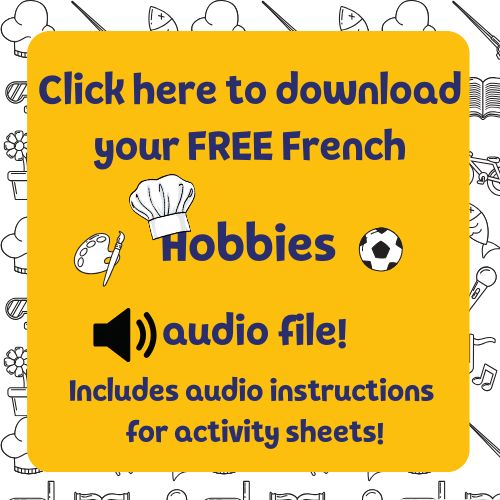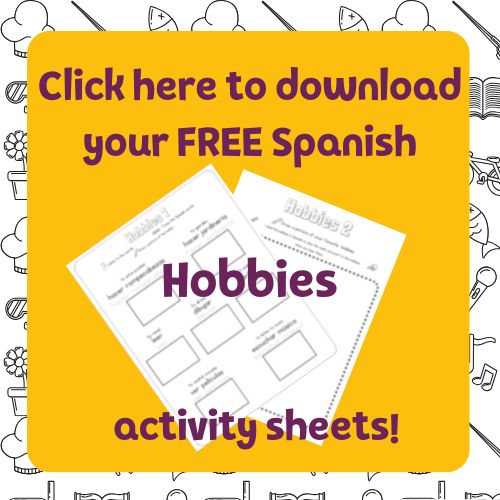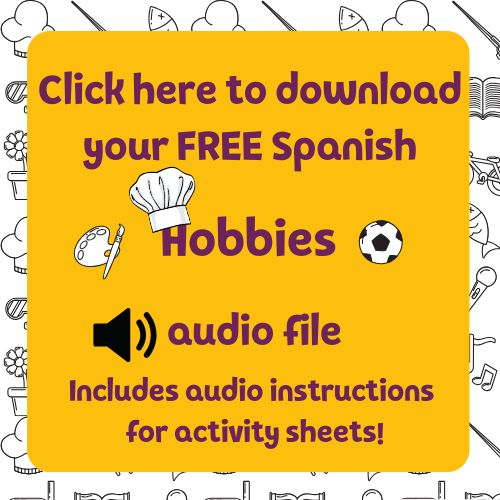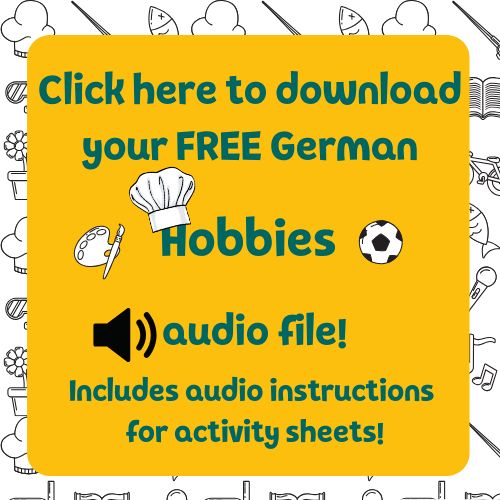
For parents and teachers introducing children to a new language, hobbies offer a natural way to explore vocabulary and make learning fun. By integrating new words into familiar activities, kids can build language skills while they enjoy their favorite pastimes! This post will provide you with practical ideas to get started and includes a free printable activity and an audio guide with pronunciation help. You can also click on the links when provided to visit some of our other free resources.
Why Hobbies Make Language Learning Fun
Hobbies like cooking, gardening, or crafting engage kids in ways that feel comfortable and enjoyable. They’re a great way to introduce new vocabulary related to things children already understand and love. When children can see, touch, and even taste what they’re talking about, the words become more memorable.
Easy Ways to Use Hobbies for Language Learning at Home
Here are a few simple ideas for introducing hobby-related words in a new language. These can be adjusted based on your child’s interests and your family’s favorite activities.
1. Cooking and Baking
- Vocabulary Focus: Utensils, ingredients, actions (e.g., mix, stir, pour).
- How-To: Choose a simple recipe that’s easy to follow, like baking cookies or preparing a fruit salad. Label ingredients and utensils in the target language. As you cook together, introduce the words and practice saying them out loud.
- Practice Tip: Encourage your child to repeat each word and even “teach” it to another family member!
2. Arts and Crafts
- Vocabulary Focus: Colors, shapes, tools (e.g., scissors, glue, paper).
- How-To: Set up a crafting session using supplies labeled in the target language. As you go through each step, mention the names of tools and colors in the new language, like “Use the scissors (say word in new language) to cut the paper (say word in new language).”
- Practice Tip: Make a craft dictionary! After completing the craft, let your child create a mini-dictionary by drawing or pasting a picture of each item and labeling it in the target language.
3. Gardening or Nature Exploration
- Vocabulary Focus: Plants, outdoor items, nature actions (e.g., dig, water, plant).
- How-To: Gardening offers a great opportunity for outdoor vocabulary. Have your child help with planting flowers or taking care of herbs. As they dig and water, say the action words in the target language.
- Practice Tip: Start a garden journal with your child, noting the plant names and actions in both languages. You can review it regularly to reinforce their learning.
4. Sports and Outdoor Games
- Vocabulary Focus: Sports equipment, actions (e.g., run, throw, kick), and simple game rules.
- How-To: Introduce vocabulary through active play. For instance, if you’re playing soccer, you can introduce words for “ball,” “kick,” and “goal” in the target language.
- Practice Tip: Incorporate phrases like “Let’s kick the ball!” or “It’s a goal!” in the new language to help them connect actions with words.
5. Music and Dance
- Vocabulary Focus: Instruments, music styles, actions (e.g., play, sing, dance).
- How-To: Introduce children to the names of instruments in the target language or use music from countries that speak the language they’re learning. Encourage them to follow along with simple dance moves while naming each instrument they hear.
- Practice Tip: Make a simple playlist and encourage your child to request songs in the target language. You can also introduce them to traditional music styles from other cultures!
Using Printables and Audio to Support Vocabulary Learning
If you haven’t ordered your One Third Stories subscription yet, or if you’re looking for some additional ways to practice, we’ve created free printable activity sheets introducing different hobby words. These sheets are a fantastic way for children to practice the words during their activities.
Alongside the printables, an audio guide provides directions for the activity sheets and pronunciation help. Kids (and adults!) can listen to the correct way to say each word, helping them feel more confident in their pronunciation.
Tips for Success
- Keep it light and fun: Language learning should feel like a game, not a chore. Praise their efforts and have fun with each activity.
- Be patient: Repetition is key. Don’t worry if your child doesn’t remember every word right away. The goal is to enjoy learning together.
- Encourage them to teach others: One of the best ways to learn is by teaching. Let them “teach” the words they learn to family members or friends.
Download Your Free Printables and Audio Guide
See below to download your free hobby-themed language learning printables and audio pronunciation guide. These resources provide a wonderful way to start your language-learning journey together and make it a family affair!
With these activities, you’re not just teaching your child new words; you’re helping them build a lifelong love of language. Enjoy exploring your hobbies together—now with a whole new vocabulary set!


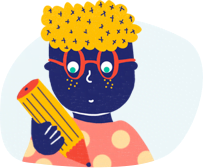
Choose a language
One Third Stories courses are available in French, Spanish, Italian and German.
Select a subscription
Choose between monthly or annual payment options.
Start learning
Receive your first audiobook and Story Box, and let the learning begin!.

Choose a language
Our courses are available in French, Spanish, Italian and German.

Select a subscription
Choose between monthly or annual payment options.

Start learning
Receive your first audiobook and Story Box, and let the learning begin!.


